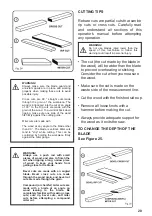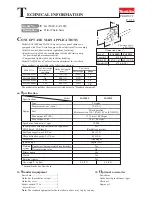
16
Insert the blade and wrench into the
holes on the side of the table saw and
securely tighten the screws. Push rod
and power cord have onboard storage
as shown in Fig. 18.
WARNING!
Don't let familiarity with the tools make
you careless. Remember that a
fraction of carelessness in a second is
enough to inflict serious injury.
WARNING!
Always wear protection to eyes with
side shields marked to meet ANSI
Z87.1. Failure to do so could throw
objects into your eyes, which could
cause serious injury.
WARNING!
Do not use attachments or
accessories not recommended by the
manufacturer of this tool. The use of
non-recommended attachments or
accessories can result in serious
personal injury.
WARNING!
Although many of the illustrations in
this manual are shown with the blade
guard removed for clarity, do not
operate the saw without the blade
guard unless specifically instructed to
do so.
APPLICATIONS
You can use this tool for the purposes
listed below:
• Straight line cutting operations such
as cross cutting, rip cutting, miter
cutting, bevel cutting and compound
cutting.
•
Manufacture of cabinets and
carpentry.
NOTE:
This table saw is designed to
cut only wood and wood composition
products.
BASIC OPERATION OF THE TABLE
SAW
The polarized plug must be plugged
into an outlet that is properly installed
and grounded in accordance with all
local
codes
and
ordinances.
Improper connection of equipment can
cause electric shock. Do not modify the
plug if it does not fit into the outlet.
Have the outlet properly installed by a
qualified electrician. See the Electrical
section in this manual.
CAUSES OF KICKBACK
Kickback can occur when the blade
stops or binds, throwing the workpiece
at you with great force and speed. If
your hands are near the saw blade,
they can be shaken off the workpiece
and may come into contact with the
blade. Kickback can cause serious
injury. Use precautions to avoid risks.
Kickback can be caused by any action
that jams the blade into the wood, such
as:
• Make a cut with the wrong blade
depth.
• Sawing into knots or nails in the
workpiece.
• Twist the wood while making a cut.
Not supporting what you are cutting.
• Force a cut.
• Wet wood cutting.
• Using the correct blade for the type of
cut.
• Failure to comply with proper
operating procedures.
Summary of Contents for PRO-SB1800
Page 1: ...Table Saw User s Manual Model No PRO SB1800 English 2 I Español 50 ...
Page 37: ...37 ...
Page 41: ...NOTES ...
Page 42: ...NOTES ...
Page 43: ...NOTES ...
Page 44: ...NOTES ...
Page 45: ...NOTES ...
Page 46: ...NOTES ...
Page 47: ...NOTES ...
Page 48: ...www promakertools com ...
Page 49: ...Sierra de Banco Manual del Usuario Modelo No PRO SB1800 ...
Page 91: ...91 LISTA DE PIEZAS ...
Page 95: ...NOTAS ...
Page 96: ...www promakertools com ...
















































